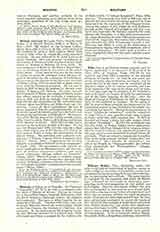

Milevum, a titular see of Numidia. In Ptolemy’s “Geography”, IV, iii, 7, the city is mentioned under the name of Mileum or Mireon. During the Roman era it was called Colonia Sarnensis Milevitana, after the River Sarnus in Campania, whence the colonists had emigrated. This name is often found in the inscriptions of the city. Together with Cirta, Collo, and Rusicade, Milevum formed the confederation known as the Four Colonies, the territory of which was very extensive. In the sixth century the Emperor Justinian had Milevum enclosed by a fortified wall, which still stands and forms a rampart for the Arabian city of Milah (Diehl, “L’Afrique byzantine”, Paris, 1896, 603 sq.). Two councils were held at Milevum, one in 402 and the other in 416; the second appealed to Pope Innocent I for the repression of the Pelagian heresy. Among the bishops of this titular see were Pollianus, present at the Council of Carthage in 255 and martyred two years later; St. Optatus, noted for his work against the Donatists, d. c. 385, and commemorated on June 4; Honorius; Severus, fellow-countryman and friend of St. Augustine; Benenanus (484); Restitutus, who attended the Fifth Ecumenical Council in 553. Milevum, now Milah, is a city in the department of Constantine in Algeria, with 8000 inhabitants, 400 of whom are Europeans. We have quite a number of Latin inscriptions from this city and a colossal statue of Saturn.
S. VAILHE

